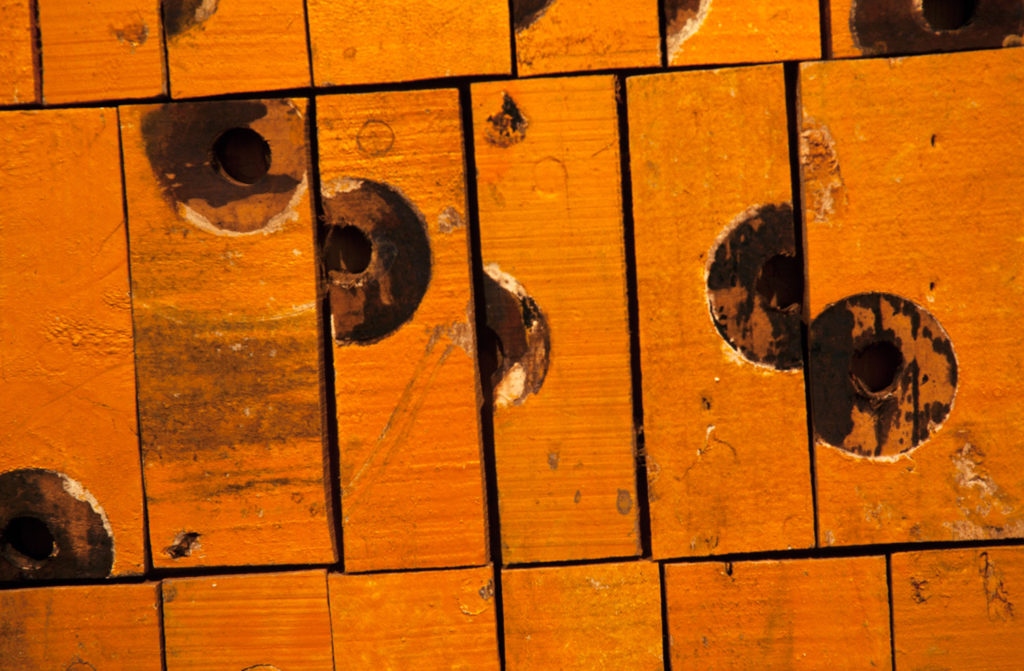CURATOR Gregory O'Brien PUBLICATION publisher Victoria University Press and City Gallery Wellington; essays Barbara Anderson, Gregory O'Brien, Daniel Thomas
For the Festival of the Arts, City Gallery mounts a survey of expatriate artist Rosalie Gascoigne. It's the first major New Zealand show of her work since the National Art Gallery's 1983 touring show, and the first survey since her death in 1999, aged eighty-two.
Gascoigne spent most of her adult life in Australia, becoming an artist late in life. Born in Auckland in 1917, she studied languages and mathematics at university, before moving to Australia in 1943 with her husband, Ben Gascoigne, an optical astronomer. They lived outside Canberra, near the Blue Mountains, in Mount Stromlo, the site of the Commonwealth Solar Observatory, where he worked. Gascoigne raised their three children in this small isolated community of eight houses around a cluster of telescopes. There, she took up quilt-making, then ikebana—particularly of the avant-garde Sogetsu school.
In 1974–5—aged fifty-seven—she was asked to participate in an art show in Sydney. Within three years, she had a solo show at Melbourne's National Gallery of Victoria. In 1982, became the first woman artist to represent Australia at the Venice Biennale. Asked why she became an artist, Gascogine said, 'Desperation, filling the void. Everything being not enough, having an astronomer husband who went away and looked at the stars all the time. That sort of thing.' In the Evening Standard Fran Dibble writes, 'She is so different from our stereotypical view of the "artist" ... A middle-class woman, wife, and mother, she began her career in art at the age of fifty-eight, with no formal training.'
Gascoigne's process involves finding, arranging, constructing, and assembling found materials. The earliest works include box constructions, like The Colonel's Lady (1976), which combines old plastic dolls, beer labels, Kiwi boot polish, barbed-wire packets, and a Bitter Ale can. Feathered Chairs (1978) is made from swan feathers, arranged into the wooden frames of two discarded chairs. Birds and bird song are recurring motifs. The seashells in Turn of the Tide (1983) evoke Gascoigne's life-long beachcombing habit. She was later dubbed a 'hunter gatherer in a station-wagon', collecting everything from sheep bones to Schweppes boxes for her art.
Gascoigne called her assemblages 'stammering concrete poetry'. The show highlights her abstract treatment of words across a range of works, from Cocktaoos (1990) to the abstract looping Birdsong (1999) and Metropolis (1999), her last and largest road-sign work. As the viewer walks towards it, their shadow and reflection cross. Gascoigne gifted it to the Art Gallery of New South Wales, Sydney, shortly before her death.
Several floor-based installations are included. Habitation (1984) is made of rusted enamel mugs and old soft-drink crates, while Piece to Walk Around (1981) is just that—a floor work of piles of saffron thistle sticks arranged in a grid. Plein Air (1994)—an installation of wall panels and freestanding items, including box wire—attempts to describe or contain air. The title also refers to the importance of the outdoors for Gascoigne.
Landscape is Gascoigne's predominant preoccupation. Her large works, like Monaro (1989), composed from Schweppes crates, evoke the big skies and scrub land of the Australian outback. The survey also addresses the way Gascoigne has processed memories of other locations—including New Zealand. It shows the influence of the New Zealand high country and other landforms and also her admiration of Colin McCahon. The bays of her childhood home are evoked in Twofold Bay (1988) and Landfall (1989). Skylark (1994) is a direct homage to McCahon, its ten floating vistas of landscape recalling his rolling green hills.
Saatchi & Saatchi do the show's marketing campaign. The invitations are glued to scraps of wood and the tagline is 'Australia's most famous New Zealand artist.' But local reviewers aren't buying it. In Museum News Aotearoa, Mark Amery writes, 'To my eyes, New Zealand appears in her work only as a distant echo, with the additional reflection of her admiration for the work of Colin McCahon.' 'It was Australia that formed Gascoigne as an artist,' William McAloon asserts in the Listener, 'given this she'd probably have blanched at the tag-line, "Australia's most famous New Zealand artist".' And in the Evening Standard, Fran Dribble says, 'The exhibition has artworks that are inspired by the New Zealand high country and works influenced by Colin McCahon. But in spite of this selection, the works are still utterly Australian.' Nevertheless, the show is well reviewed. Dribble concludes, 'Her works speak an aesthetic language, they are visual poems that express sharp emotions.'
On the opening weekend, Gascoigne's husband Ben and son Martin Gascoigne give a tour of the show. The public programme also includes an Ikebana workshop.



















































































































